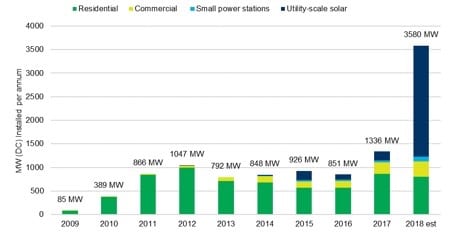While 2017 was a record year for the solar PV industry in Australia, it will be completely put in the shade by what we’re likely to install in 2018.
Our data shows a total 1340 MW of solar PV was installed and operational by the end of December 2017.
This is a big number by the standards of Australia’s overall electricity market, not just the solar sector.
Yet in 2018 the industry is on track to commission 2.6 times this level of solar PV with more than 3500 MW expected to be installed, once you consider the significant number of large-scale solar projects that were under construction at the end of 2017
To put this activity into perspective, the construction activity for large-scale solar will directly support the employment of 4423 people on a job year basis.
In addition, there were more than 4,500 people directly employed in the sale and installation of roof-top solar over 2017 (see Green Energy Markets’ Renewable Index for further detail).
These people have commissioned nearly 5 million solar panels in 2017 and will commission more than 13 million solar panels in 2018.
Solar PV capacity installed in Australia (MW DC)

We have analysed the level of PV installations by market sector – residential, commercial, small power stations and utility-scale installations. Importantly, we have changed our classification of commercial systems and now deem that systems above 15 kW are commercial.
Analysis of our associate company Green Energy Trading’s creation over the last few years found that that the size of residential systems has increased considerably and that 15 kW was more representative of a non-residential system.
Queensland and NSW were the biggest markets for solar PV in 2017 accounting for 33% and 25% share respectively.
The residential market remains the mainstay of the PV industry accounting for 64% of total installations in 2017 with the commercial sector accounting for 18%. The utility-scale installations in 2017 amounted to 185 MW on a DC basis in 2017.
Green Energy Markets’ Renewables Report indicates that we can expect more than 2,300 MW (DC) of utility-scale projects will be commissioned in 2018.
Solar PV capacity installed (MW DC)

The dramatic increase in the level of installations can be explained by:
- Increasing media focus on energy security and higher prices particularly following the blackout in South Australia in 2016 as well as the closure of the Hazelwood power station. This has acted to generate a desire amongst households and businesses to take greater control over their electricity supply and an interest in installing solar;
- Higher wholesale prices which also flowed into higher feed-in tariffs, improved the economics of PV and made it a more financially attractive proposition for customers; and
Significant reductions in the installed cost of larger scale solar systems and support from ARENA has seen this sector start to gain momentum over the last 12 months. There was more than 2300 MW (DC) of large-scale solar under construction at the end of 2017 which will underpin a significant increase in 2018.
Methodology and Notes
- We have utilised certificate creation data from the REC-Registry to determine the level of residential and commercial installations. An estimated 1078 MW of solar PV was submitted to create Small-scale Technology Certificates (STCs) and we have allowed for an average of one month’s lag in certificate creation to estimate the expected level of installations that occurred in 2017.
- For small power stations, we have only included those installations that received accreditation from the Clean Energy Regulator in 2017 and note that there were more than 80 small power stations that had submitted applications for registration at the end of December 2017, many of which would have been commissioned in 2017.
- PV market segments are based on the size of the installation as follows:
- Residential – systems installed up to and including 15 kW in size;
- Commercial – systems installed between 15 kW and 100 kW
- Small power stations – systems above 100kW that need to be registered as power stations under the renewable energy target; and
- Utility scale – systems installed greater than 5 kW (AC) in size
- Employment figures for the solar industry were sourced from the Green Energy Markets’ Renewable Index.
Ric Brazelle is director of Green Energy Markets








